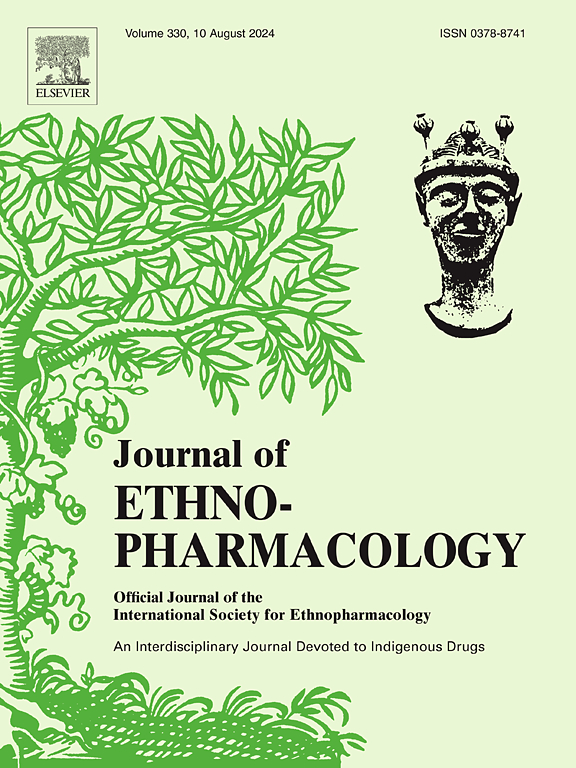成骨通过PI3K/AKT信号通路抑制骨质疏松大鼠骨髓间充质干细胞凋亡。
IF 5.4
2区 医学
Q1 CHEMISTRY, MEDICINAL
引用次数: 0
摘要
在中国,骨质疏松是一种常用的治疗和预防骨质疏松的措施。骨质疏松的病理生理与细胞凋亡密切相关;然而,目前尚不清楚成骨促进骨形成的作用是否与细胞凋亡有关。研究目的:本研究旨在探讨成骨是否通过PI3K/AKT信号通路抑制骨质疏松大鼠骨髓间充质干细胞凋亡,并对其机制进行详细探讨。目的是为骨固定在骨质疏松症治疗中的临床应用提供理论依据。方法:采用双侧卵巢切除术(OVX)建立大鼠骨质疏松模型,并进行成骨治疗。治疗10周后,评估骨密度。测量左胫骨的生物力学,对左股骨进行测序,并对右胫骨进行组织形态学和Masson染色。收集外周血清,测量骨相关标志物,包括E2、PINP和CTX。使用剩余的骨样本验证RNA-Seq结果。对比分析证明了骨固定治疗骨质疏松症的有效性,并对其潜在机制提供了初步的见解。采用骨髓移植培养原代骨髓间充质干细胞。CCK8检测筛选Osteoking和LY294002的干预条件。分别检测不同浓度的含骨血清和LY294002,确定最佳给药干预浓度。我们还评估了成骨对脂质形成的影响。用Sham血清、OVX血清、OVX+LY294002血清和Osteoking+LY294002血清处理OVX大鼠骨髓间充质干细胞后,评估PI3K/AKT/mTOR、成骨相关调节因子和凋亡相关调节因子的表达。流式细胞术检测骨髓间充质干细胞的凋亡情况。结果:成骨术显著改善OVX大鼠全身骨密度和骨生物力学指标。血清E2、PINP水平明显升高,CTX水平明显降低,显著改善骨微结构,促进新骨形成。RNA-seq分析表明,其治疗机制涉及PI3K/AKT信号通路。在OVX大鼠中,成骨增加RUNX2的表达,降低PPAR-γ(脂肪生成标志物)的表达。提取骨髓间充质干细胞用于后续研究显示,OVX组的增殖和成骨分化显著减少,同时增脂分化。成骨处理可抑制骨髓间充质干细胞中PPAR-γ的表达,增加RUNX2的表达。此外,Osteoking逆转了ly294002介导的PI3K/AKT/mTOR信号通路激活抑制,增加了凋亡保护蛋白Bcl2的表达,降低了凋亡相关蛋白Caspase3和Bax的表达。结论:成骨术可显著改善OVX大鼠的骨微观结构、生物力学和骨密度。含骨血清逆转了OVX大鼠谱系分化的不平衡,其特征是成骨分化减少,骨髓间充质干细胞脂质分化增加。此外,含骨血清通过PI3K/AKT信号通路显著增加OVX大鼠BMSC增殖并阻止细胞凋亡。本文章由计算机程序翻译,如有差异,请以英文原文为准。

Osteoking inhibits apoptosis of BMSCs in osteoporotic rats via PI3K/AKT signaling pathway
In China, Osteoking is a commonly used treatment and preventive measure for osteoporosis. The pathophysiology of osteoporosis is closely associated with apoptosis; however, it remains unclear whether the role of Osteoking in promoting bone formation is linked to apoptosis.
Aim of study
This study aims to investigate whether Osteoking inhibits apoptosis of BMSCs in osteoporotic rats via the PI3K/AKT signaling pathway and to conduct a detailed exploration of this mechanism. The goal is to provide a theoretical basis for the clinical application of Osteoking in osteoporosis treatment.
Methods
A rat model of osteoporosis was established through bilateral ovariectomy (OVX), followed by treatment with Osteoking. After ten weeks of therapy, BMD was evaluated. The biomechanics of the left tibia were measured, the left femur was sequenced, and the right tibia was stained using histomorphometric and Masson's staining methods. Peripheral serum was collected to measure bone-related markers, including E2, PINP, and CTX. RNA-Seq results were verified using the remaining bone samples. Comparative analysis demonstrated the efficacy of Osteoking in treating osteoporosis and provided preliminary insights into the underlying mechanisms. Primary BMSCs were cultured using bone marrow apposition. CCK8 assays were conducted to screen the intervention conditions of Osteoking and LY294002. Various concentrations of Osteoking-containing serum and LY294002 were tested separately to determine the optimal intervention concentration for drug delivery. The impact of Osteoking on lipid formation was also evaluated. Following treatment of BMSCs from OVX rats with Sham serum, OVX serum, OVX + LY294002 serum, and Osteoking + LY294002 serum, the expression of PI3K/AKT/mTOR, osteogenesis-related regulatory factors, and apoptosis-related regulatory factors was assessed. Flow cytometry was employed to evaluate apoptosis in BMSCs.
Results
Osteoking significantly improved whole-body BMD and bone biomechanical indices in OVX rats. It also significantly elevated the serum levels of E2 and PINP while reducing the level of CTX, which significantly improved bone microstructure and promoted new bone formation. RNA-seq analysis indicated that the therapeutic mechanism involved the PI3K/AKT signaling pathway. Osteoking increased the expression of RUNX2 and decreased the expression of PPAR-γ, a marker of lipogenesis, in OVX rats. Extraction of BMSCs for subsequent studies revealed a significant reduction in proliferation and osteogenic differentiation, along with an increase in lipogenic differentiation, in the OVX group. Osteoking treatment inhibited the expression of PPAR-γ and increased the expression of RUNX2 in BMSCs. Additionally, Osteoking reversed the LY294002-mediated inhibition of PI3K/AKT/mTOR signaling pathway activation, increased the expression of the apoptosis-protecting protein Bcl2, and decreased the expression of apoptosis-associated proteins Caspase3 and Bax.
Conclusion
Osteoking markedly improved bone microstructure, biomechanics, and bone density in OVX rats. Osteoking-containing serum reversed the imbalance in lineage differentiation in OVX rats, characterized by reduced osteogenic differentiation and increased lipid differentiation of BMSCs. Furthermore, Osteoking-containing serum significantly increased BMSC proliferation and prevented apoptosis in OVX rats through the PI3K/AKT signaling pathway.
求助全文
通过发布文献求助,成功后即可免费获取论文全文。
去求助
来源期刊

Journal of ethnopharmacology
医学-全科医学与补充医学
CiteScore
10.30
自引率
5.60%
发文量
967
审稿时长
77 days
期刊介绍:
The Journal of Ethnopharmacology is dedicated to the exchange of information and understandings about people''s use of plants, fungi, animals, microorganisms and minerals and their biological and pharmacological effects based on the principles established through international conventions. Early people confronted with illness and disease, discovered a wealth of useful therapeutic agents in the plant and animal kingdoms. The empirical knowledge of these medicinal substances and their toxic potential was passed on by oral tradition and sometimes recorded in herbals and other texts on materia medica. Many valuable drugs of today (e.g., atropine, ephedrine, tubocurarine, digoxin, reserpine) came into use through the study of indigenous remedies. Chemists continue to use plant-derived drugs (e.g., morphine, taxol, physostigmine, quinidine, emetine) as prototypes in their attempts to develop more effective and less toxic medicinals.
 求助内容:
求助内容: 应助结果提醒方式:
应助结果提醒方式:


